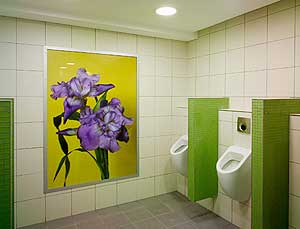
Dominique Gonsalez-Foerster's recreation,...in miniature, of great moments...from previous Skupture Projects.
I am sitting down to write about Sculpture Projects Munster almost a month after I was there, and I can say without doubt the most memorable thing about the exhibiton for me were the public toilets on Domplatz. That might sound like damning with faint praise, but if you want a really negative comment on the whole enterprise check out this statement from Benjamin Buchloh – that great killjoy of the contemporary art world:
The show has come to reflect the production of art as an advanced form of entertainment for an ever-more sophisticated and increasingly bored European middle class, which would not know where to turn without blockbuster exhibitions (a condition necessitated through an overdeveloped cultural infrastructure, with its myriad corporate-, state-, and community-supported exhibition institutions, corporate and private investment collections, and ambitious curators who fancy themselves nomads, meaning they race from city to city in service of the multinational monopoly of the culture industry). These artists seem to take as a given that the function of sculpture is to furnish these compensatory leisure spaces.
I came across that quote while scanning the web for reviews of Sculpture Projects. The above quote jumped out at me, and I had to look closer to realize that what I had found was Buchloh's ArtForum review of the 1997 installation. Which makes more sense for, having seen the 1997 version, I had been struck this year by how low on entertainment value this 2007 go round was.
The project occurs every ten years, so greater shifts can occur in the art world between exhibitions than you would expect in Biennials or even the five-year span between Documentas. Large-scale minimalist work by big-name American artists dominated the first Sculpture Projects Munster in 1977. The 1987 version is usually referred to as the “figurative year,” with Thomas Schutte's cherries and Katherina Frisch's Yellow Madonna singled out as emblematic pieces. In 1997, the first year I personally attended, there was the festive atmosphere bemoaned by Herr Buchloh. The one hundred birthday parties Yutaka Sone gave himself during the exhibition catches the atmosphere of the show.
The curatorial mandate for the projects has always been to engage public space, whether by plunking down several tons of steel or stone in 1977 or by putting on a puppet show as Rirkrit Tiravanija did in 1997. This year the engagements were most often on so conceptual a level that once you tracked down the piece by using the map, the actual experience was reduced to reading about it in the guide, either thinking, “Oh, I get it,” or not, and moving on.
The projects that presented objects were the weakest. Andreas Siekmann gathered a range of those plastic sculptures cities use for local “branding” — here in Dallas we have Pegasus. Siekmann put a bunch of them through a garbage compactor and created a huge sphere. Get it? Tue Greenfort made a fountain from a liquid manure spreader and placed it on the shore of Lake Aa. It was a witty piece of expectation inversion until you consulted the guidebook. There you learned that it was actually putting into the artificial lake the iron oxide it needs to combat the algae blooms the shallow water is prone to. Get it?
Several artists submitted films for their sculpture projects. At least you got to sit down while wondering how these films made it into a sculpture exhibition. Also, only in a city as tidy as Munster could you watch a film in an underground walkway beneath a busy street and not choke on the odor of piss and vomit.
Mike Kelly created a petting zoo this year, but that was about it on the interactive front. Except for those public toilets on Domplatz. They have been refurbished under the direction of Han-Peter Feldmann, the Dusseldorf-based artist best known for assembling books of thematically linked found photographs. For Munster he worked with the city to make the toilets on Domplatz a more pleasing experience for their users. A combination of green glass and white ceramic tiles covered the walls. He installed in each a large color photograph of a floral arrangement and over the very stylish lavatories he hung a wonderfully tacky plastic chandelier. In keeping with the democratic ideals of his work, for at least the run of the Sculpture Projects the toilets were free.
As prototypes, Feldmann's toilets are far too expensive to roll out city-wide, and so they exist only as visionary works of art. They imagine a world where art has fully integrated itself into our lives. That works of art exist most often as memories is the theme of the other great project this year in Munster. On a sloping lawn off the promenade that runs through central Munster, Dominque Gonzales-Foerster has created in 1:4 scale some of the greatest hits of the past thirty years. From a distance it looks a bit like a miniature golf course, except for the people lounging about reading, sunbathing, or making out. It provides an analytical walk down memory lane, a chance to review past experiences and the strategies that informed their aesthetic. What it cannot do is predict what shape Sculpture Projects Munster might take in 2017.




